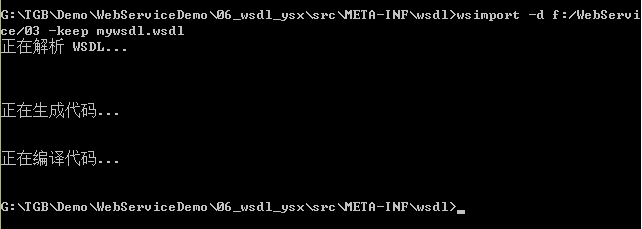相关博客:
前言:
我们先来看一个契约优先的开发实例,通过熟悉他的开发流程,最后再和代码优先的方式进行比较。
Demo中提供了两个方法add()和minus().
1、编写wsdl文件
在新建的META-INF文件下新建名称为mywsdl的wsdl文件,因为之前已经详细介绍过wsdl的结构,在这里就直接上代码了。
<?xml version="1.0" encoding="UTF-8" standalone="no"?>
<wsdl:definitions xmlns:soap="http://schemas.xmlsoap.org/wsdl/soap/"
xmlns:tns="http://www.example.org/mywsdl/" xmlns:wsdl="http://schemas.xmlsoap.org/wsdl/"
xmlns:xsd="http://www.w3.org/2001/XMLSchema" name="MyServiceImplService"
targetNamespace="http://www.example.org/mywsdl/">
<wsdl:types>
<xsd:schema targetNamespace="http://www.example.org/mywsdl/">
<!-- 1.1 编写元素add,addResponse,minus,minusResponse -->
<xsd:element name="add" type="tns:add"></xsd:element>
<xsd:element name="addResponse" type="tns:addResponse"></xsd:element>
<xsd:element name="minus" type="tns:minus"></xsd:element>
<xsd:element name="minusResponse" type="tns:minusResponse"></xsd:element>
<!-- 1.2 编写元素的类型 -->
<xsd:complexType name="add">
<xsd:sequence>
<xsd:element name="a" type="xsd:int"></xsd:element>
<xsd:element name="b" type="xsd:int"></xsd:element>
</xsd:sequence>
</xsd:complexType>
<xsd:complexType name="addResponse">
<xsd:sequence>
<xsd:element name="addResult" type="xsd:int"></xsd:element>
</xsd:sequence>
</xsd:complexType>
<xsd:complexType name="minus">
<xsd:sequence>
<xsd:element name="c" type="xsd:int"></xsd:element>
<xsd:element name="d" type="xsd:int"></xsd:element>
</xsd:sequence>
</xsd:complexType>
<xsd:complexType name="minusResponse">
<xsd:sequence>
<xsd:element name="minusResult" type="xsd:int"></xsd:element>
</xsd:sequence>
</xsd:complexType>
</xsd:schema>
</wsdl:types>
<!-- 1.3 编写message -->
<wsdl:message name="add">
<wsdl:part name="add" element="tns:add"></wsdl:part>
</wsdl:message>
<wsdl:message name="addResponse">
<wsdl:part name="addResponse" element="tns:addResponse"></wsdl:part>
</wsdl:message>
<wsdl:message name="minus">
<wsdl:part name="minus" element="tns:minus"></wsdl:part>
</wsdl:message>
<wsdl:message name="minusResponse">
<wsdl:part name="minusResponse" element="tns:minusResponse"></wsdl:part>
</wsdl:message>
<!--1.4 编写port,其中operation为方法 -->
<wsdl:portType name="IMyService">
<wsdl:operation name="add">
<wsdl:input message="tns:add"></wsdl:input>
<wsdl:output message="tns:addResponse"></wsdl:output>
</wsdl:operation>
<wsdl:operation name="minus">
<wsdl:input message="tns:minus"></wsdl:input>
<wsdl:output message="tns:minusResponse"></wsdl:output>
</wsdl:operation>
</wsdl:portType>
<!--1.5 编写binding,其中document类型为默认 -->
<wsdl:binding name="myServiceSOAP" type="tns:IMyService">
<soap:binding style="document"
transport="http://schemas.xmlsoap.org/soap/http" />
<wsdl:operation name="add">
<!-- <soap:operation soapAction="http://www.example.org/mywsdl/NewOperation"/> -->
<wsdl:input>
<soap:body use="literal" />
</wsdl:input>
<wsdl:output>
<soap:body use="literal" />
</wsdl:output>
</wsdl:operation>
<wsdl:operation name="minus">
<wsdl:input>
<soap:body use="literal" />
</wsdl:input>
<wsdl:output>
<soap:body use="literal" />
</wsdl:output>
</wsdl:operation>
</wsdl:binding>
<!-- 1.6 编写service -->
<wsdl:service name="MyServiceImplService"><!-- 与公布接口的name一致 -->
<wsdl:port binding="tns:myServiceSOAP" name="MyServiceImplPort">
<soap:address location="http://localhost:8989/ms" /><!--
发布地址 -->
</wsdl:port>
</wsdl:service>
</wsdl:definitions>
2、生成代码
同样,使用wsimport命令
在F:/WebService/03中找到生成的代码,copy到项目中。
注意:该阶段生成的代码是依据的是wsdl文件,例如:生成IMyService类中,有add()和minus()方法等。
3、发布服务
1)编写实现类
新建MyServiceImpl类,编写add(),minus()的具体实现。
需要注意的是,要制定wsdlLocation的地址,指明mywsdl的位置。
@WebService(endpointInterface="org.example.mywsdl.IMyService",
targetNamespace="http://www.example.org/mywsdl/",
wsdlLocation="META-INF/wsdl/mywsdl.wsdl")
public class MyServiceImpl implements IMyService {
public int add(int a, int b) {
System.out.println(a+b);
return a+b;
}
public int minus(int c, int d) {
System.out.println(c-d);
return c-d;
}
}2) 发布服务
注意:http://localhost:8989/ms即wsdl文件中的服务地址。
public class MyServer {
/**
* @param args
*/
public static void main(String[] args) {
Endpoint.publish("http://localhost:8989/ms", new MyServiceImpl());
}
}4、客户端测试
1)生成客户端代码
同样wsimport命令,只是最后不再是mywsdl.wsdl,而是我们服务的地址 http://localhost:8989/ms?wsdl。
2)测试
public static void main(String[] args) {
MyServiceImplService service=new MyServiceImplService();
IMyService ms=service.getMyServiceImplPort();
System.out.println(ms.add(3,5));
}小结:
WebService中有两种实现方式:代码优先和契约优先。代码优先就是先编写程序代码,再自动生成wsdl文件。而后者正好相反,通过wsdl生成服务端和客户端,有种逆向工程的意思。
契约优先的方式虽然没有代码优先简单,但他有他的的优点。首先,契约优先与web服务的语言关联性不大,不受语言的限制。其次,如果先编写代码,如果服务编号,wsdl也要改变,然后重新发布接口服务,这样是十分不合理的。
因此,如果项目小,需求变动不大,可选择代码优先。反之,则推荐契约优先的方式。























 1891
1891











 被折叠的 条评论
为什么被折叠?
被折叠的 条评论
为什么被折叠?








